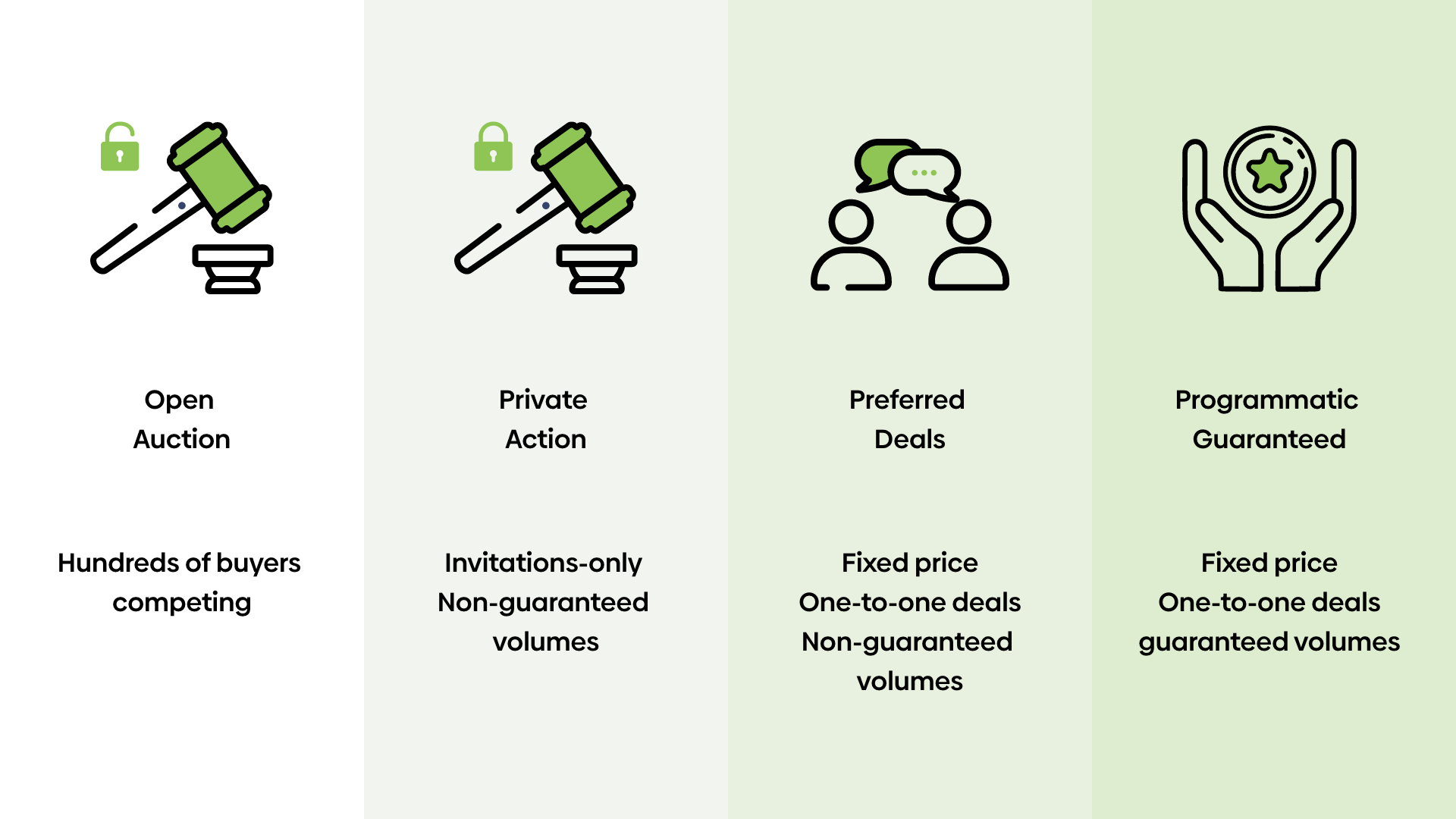Quick — what comes to mind when you think of mobile advertising? It’s probably ad mediation platforms, open auctions, and real-time bidding, right? You likely aren’t thinking about a partnership with advertisers and picturing in-person schmoozing at lunches and industry events.
But within the behemoth of programmatic advertising, which simply refers to using automated technology to buy media, there’s something called a private marketplace (PMP) auction.
PMPs involve negotiating contracts for certain deals with publishers and advertisers. It may mean dealing with advertisers on a one-on-one basis, getting on the phone, or meeting in real life. PMPs are the opposite of an open auction and if you’re looking to build deeper and fruitful relationships, a partnership marketing strategy is important.
There are certainly pros and cons to PMPs and keeping up with advertiser relationships. In this article, you will learn:
- The different types of PMPs and what each one entails.
- How to build your B2B partner marketing strategy by establishing strong communication and transparency.
We break it down into two parts — the first half explores the different types of PMP deals to help determine if it’s right for you.
In the second half, Chartboost’s Product Manager of PMP, Richard Chow, shares his expertise on the best ways to work with advertisers to build long-term, lucrative partnerships.
Part 1: Different types of private marketplace auctions
Private marketplace auctions
- Pros: More control and transparency to create inventory packages and marketplaces for your buyers that benefit your business the most.
- Cons: They aren’t guaranteed and the advertiser doesn’t have to buy.
A PMP auction, also known as a closed auction, is an invite-only auction that is made directly between publishers and advertisers.
Unlike open auctions, PMPs give you and advertisers the opportunity to collaborate directly and build relationships while allowing you to offer your best inventory. Think old-school — more interaction, deal-making, phone calls, win-win contracts — in a new-school, digital world.
The inventory within a PMP is more exclusive and expensive. Therefore the demand for your premium inventory will increase and you’ll be able to fetch a much higher price from trusted buyers. You’re dealing with higher quality for much higher CPMs than on the open market.
While not a guaranteed way to make advertisers purchase your inventory, they have priority access to these impressions at a pre-negotiated CPM before it’s made available on the open market. If you are interested in a more definite way to revenue, there is another type of deal called programmatic guaranteed (more on that below).
Programmatic direct
- Pro: You know what to expect, such as how many impressions an ad will be displayed for and at what price.
- Con: Could be more time-consuming with back and forth negotiations and finding a compromise.
Direct ad sales deals means advertisers can buy inventory directly from publishers, one on one. A direct deal requires more human involvement than any other programmatic deal. It’s important to consider how you should go about establishing strong communications and maintaining healthy relationships with partners.
Programmatic direct allows you to engage with advertisers and negotiate for things such as fixed CPMs while eliminating the need for an ad exchange.
It also can provide transparency and confidence in an ad purchase. It also simplifies sales as it occurs in a single system.
The appeal of programmatic direct
Programmatic direct deals can help guarantee that your premium ad spaces are filled and you receive better rates for them, relative to the free market. There’s potential for higher returns because you set higher rates and CPMs.
Programmatic direct also provides improved monitoring and insight. You know the type of inventory and the demographic (age, gender, geo) the advertiser is aiming for, and can properly manage the costs and value of your traffic. This also allows you to calculate sales more accurately.
Despite all that upside, there’s no promise you’ll sell your entire ad inventory. More than likely, you’ll have to turn to an ad exchange to sell the remainder. There’s nothing wrong with that, but you may not get that premium price when you sell on the open market.
Also, if your business is on the smaller side or hasn’t built up enough traffic, you may not be as attractive to advertisers.

Preferred deal
- Pro: You may have the opportunity to build long-term relationships with certain advertisers.
- Con: The advertiser isn’t obligated to buy the ad inventory.
This is another one-to-one deal that gives priority access to a publisher’s premium inventory at a much higher rate than they would have gotten in an open auction.
Consider it to be a single price for a single advertiser. However, the advertiser doesn’t have to bid at the agreed-upon price. The advertiser gets the first-look option (which reserves inventory to ensure goals are achieved) to bid at that price.
A preferred deal has higher priority than private auction PMPs, and even though it’s not guaranteed, you can still negotiate rates.
Programmatic guaranteed
- Pro: Lowest fees because middlemen such as SSPs and DSPs are eliminated
- Con: Tough for smaller publishers to attract top advertisers
Guaranteed deals are similar to preferred deals, except for one thing: this deal requires the advertiser to buy the ad space. In other words, they can’t step away but must purchase the ad space at a fixed CPM. The advertiser will commit to a certain spend to guarantee the revenue for you.
Programmatic guaranteed means publishers and advertisers can determine pricing, volume, and campaign success metrics. Once this deal has been made, this inventory is reserved and sold at a specific price with a fixed volume of impressions.
Guaranteed deals can be a great option for both parties because advertisers get to buy the premium ad inventory at a mutually decided price and volume while publishers receive guaranteed revenue.
Part 2: How to establish strong relationships with advertising partners
Richard Chow, who heads up Chartboost’s private marketplace programmatic advertising, believes strong relationships require partnership marketing strategies for establishing expectations for success and clear communication with regular feedback.
Think through the frequency of communication: how often to send emails, set up calls and meetings, what to share with advertisers, and how to streamline processes.
Clear and consistent communication
Remember, the squeaky wheel gets the grease. When working with partners, it’s important to be able to talk openly about what you think would be mutually beneficial.
Chow explains, “Let your partner know you want to be involved to build your partnership marketing strategy. For example, when the advertiser wants to test new features, new formats, and auction types, raise your hand and be in the mix.”
How to establish a regular cadence of communication is really up to you and your team’s resources and working style. Consider a variety of approaches, including email check-ins, quick phone calls, meetings for lunch, or attending the same industry events.
While it may seem insignificant, keeping in regular contact and establishing face-time goes a long way.
Streamline partnership processes
When scaling relationships with multiple partners, many of the same questions will inevitably arise. Partners will want to know which ad formats or campaign types have worked best in the past, and ask about goals.
“Get the information you need from the partner in a document, such as the status quo of features and functionalities. Templatize this information and have it ready to go for the next partner.”
Chow also suggests creating a talk track and sharing your roadmap to give advertiser partners an overview of what you specifically hope to accomplish in the partnership.
Be transparent
It’s important to be willing to share your own goals, such as what kind of deal types you prefer and your budget. If you have a specific PMP or a programmatic guaranteed budget, figure out the breakdown and share it with your partner.
From a revenue standpoint, it might seem ideal to secure a direct or guaranteed deal, but keep your options open.
“It’s really about making sure the advertiser is aware of your ad stack and which partners you use. It’s important for the advertiser to understand that this is how you would like to transact and then find a route that is most efficient between the two.”
Building your PMP presence
The right PMP can deliver transparency that locks you and your advertisers into a pre-negotiated deal as well as more visibility over your inventory. Advertisers and omnichannel buyers see PMPs as an essential way to test your inventory.
While there may be more work required to maintain advertiser relationships and commission fees, PMPs are a natural part of the ad stack and could be the right move for you if you’re a publisher seeking higher returns, more control, and greater transparency.
Interested in gaining higher revenue and greater transparency from your partnership marketing strategy? See how Chartboost can help build your mobile business with in-app monetization, ad mediation, and programmatic advertising.



